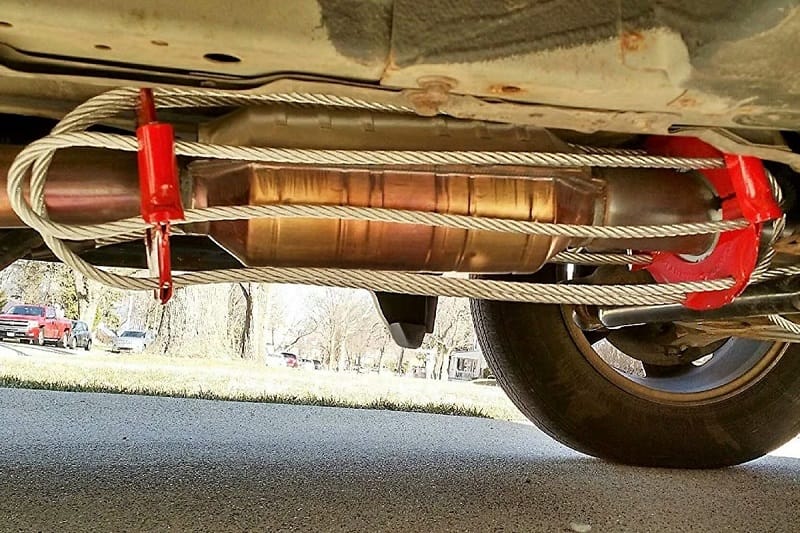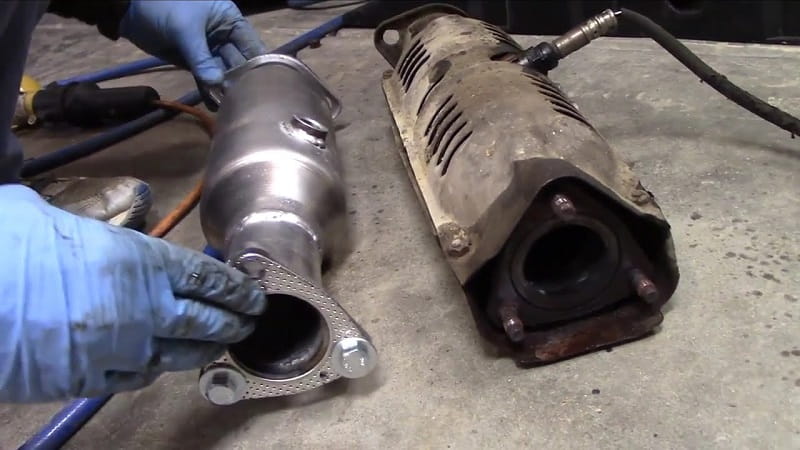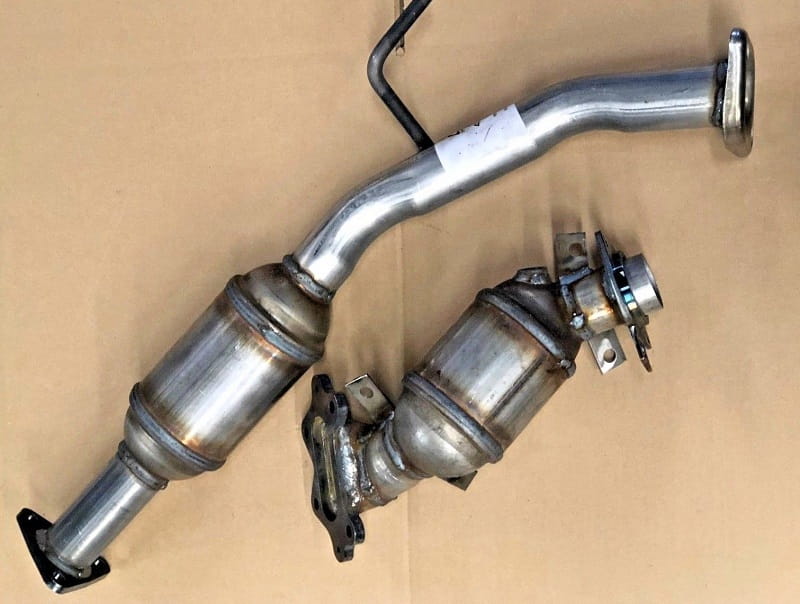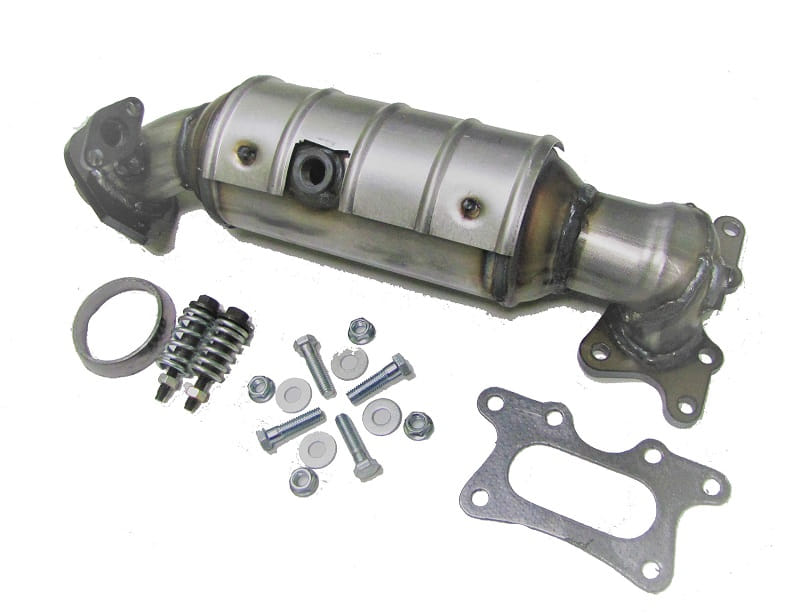This post contains affiliate links. This means I will make a commission at no extra cost to you should you click through and make a purchase [ “As an Amazon Associate, I earn from qualifying purchases.” ]. Read the full disclosure here.
Catalytic Converter for Honda Civic GuideMechanic.Com Are you a proud owner of a Honda Civic and want to learn more about its catalytic converter? Look no further! In this comprehensive blog article, we will delve into the world of catalytic converters specifically designed for Honda Civic vehicles.
From understanding their importance to discussing the different types and their benefits, we’ve got you covered. So, let’s get started on this informative journey!
First and foremost, let’s understand what a catalytic converter actually is. A catalytic converter is an essential component of your Honda Civic’s exhaust system.
Its primary function is to convert harmful pollutants emitted by your vehicle into less harmful substances before they are released into the atmosphere. By doing so, it helps to minimize the environmental impact of your car’s emissions, making it more eco-friendly.
Catalytic Converter for Honda Civic [ The Role of Catalytic Converters ]

In this section, we will explore the crucial role catalytic converters play in reducing harmful emissions from your Honda Civic. We will discuss how they work and provide an overview of the chemical reactions that take place within the converter.
How Catalytic Converters Work
A catalytic converter contains a catalyst, typically made of platinum, palladium, and rhodium, which facilitates the chemical reactions that occur during the conversion process.
As the exhaust gases flow through the converter, the catalyst triggers a series of chemical reactions that break down harmful pollutants, such as carbon monoxide, nitrogen oxides, and unburned hydrocarbons, into less harmful substances like carbon dioxide, nitrogen, and water vapor.
Chemical Reactions Inside the Catalytic Converter
Within the catalytic converter, there are two main stages of chemical reactions: reduction and oxidation. In the reduction stage, the catalyst helps to convert nitrogen oxides (NOx) back into nitrogen and oxygen.
In the oxidation stage, unburned hydrocarbons and carbon monoxide react with oxygen to produce carbon dioxide and water vapor.
By understanding the process and chemical reactions that occur within the catalytic converter, you can appreciate its vital role in reducing harmful emissions and promoting a cleaner environment.
Different Types of Catalytic Converters

Here, we will dive into the various types of catalytic converters available for your Honda Civic. From two-way to three-way converters, we will discuss their differences and functionalities, helping you make an informed decision when choosing the right one for your vehicle.
Two-Way Catalytic Converters
Two-way catalytic converters, also known as oxidation catalytic converters, primarily focus on reducing carbon monoxide and unburned hydrocarbons from the exhaust gases.
See Also: Honda Element Catalytic Converter Shield
They do not effectively reduce nitrogen oxides. These converters are commonly found in older Honda Civic models and are less efficient compared to three-way converters.
Three-Way Catalytic Converters
Three-way catalytic converters are the most common type found in modern Honda Civic vehicles. As the name suggests, they can simultaneously reduce carbon monoxide, unburned hydrocarbons, and nitrogen oxides from the exhaust gases. They achieve this through a more advanced catalyst formulation and a sophisticated oxygen sensor system.
Ceramic vs. Metallic Catalytic Converters
In addition to the different types mentioned above, catalytic converters can also be classified based on their substrate material, which can be either ceramic or metallic.
Ceramic converters are more commonly used due to their excellent thermal efficiency and durability. Metallic converters, on the other hand, offer better resistance to physical damage and can withstand higher temperatures.
The choice between ceramic and metallic converters depends on your specific requirements and the model of your Honda Civic.
By understanding the different types of catalytic converters available for your Honda Civic, you can choose the one that best suits your vehicle’s needs and environmental goals.
OEM vs. Aftermarket Catalytic Converters

Should you go for an original equipment manufacturer (OEM) catalytic converter or choose an aftermarket one? In this section, we will compare the pros and cons of both options, enabling you to make a well-informed decision based on your preferences and budget.
OEM Catalytic Converters
OEM catalytic converters are manufactured by the same company that produced the original converter installed in your Honda Civic.
These converters are designed to meet the exact specifications and performance requirements of your vehicle. They are often more expensive than aftermarket converters but are known for their reliability and compatibility.
Aftermarket Catalytic Converters
Aftermarket catalytic converters are produced by third-party manufacturers and offer an alternative to OEM converters. They are available at a lower price point and may offer additional features or improvements over the original converter.
However, it is essential to ensure that the aftermarket converter meets emission standards and is compatible with your Honda Civic model.
Pros and Cons of OEM and Aftermarket Converters
Choosing between OEM and aftermarket catalytic converters depends on several factors. OEM converters provide peace of mind in terms of compatibility and reliability but come at a higher cost.
Aftermarket converters offer cost savings but may require more research to ensure they meet emission standards and fit your specific Honda Civic model. Consider your budget, warranty preferences, and environmental goals when making a decision.
By weighing the pros and cons of OEM and aftermarket catalytic converters, you can make an informed decision that aligns with your needs and budget.
Signs of a Failing Catalytic Converter

Recognizing the symptoms of a failing catalytic converter is crucial for timely repairs or replacements. In this section, we will discuss the common signs to look out for, such as reduced engine performance, unusual exhaust odor, and illuminated warning lights.
Reduced Engine Performance
A failing catalytic converter can lead to decreased engine performance, including reduced acceleration and power output.
If you notice that your Honda Civic is struggling to maintain speed or experiencing a loss of power, it could be an indication of a failing converter.
Unusual Exhaust Odor
A strong and unpleasant odor coming from your vehicle’s exhaust can be a sign of a failing catalytic converter. This odor is often described as a rotten egg smell, resulting from the incomplete combustion of sulfur compounds in the exhaust gases. If you notice this odor, it is essential to have your catalytic converter inspected.
Illuminated Warning Lights
The “Check Engine” or “Malfunction Indicator Lamp” (MIL) light on your Honda Civic’s dashboard can indicate various issues, including a failing catalytic converter.
If the light is illuminated, it is advisable to have your vehicle diagnosed by a professional mechanic to identify the exact cause of the issue.
Other Symptoms
Additional symptoms of a failing catalytic converter may include increased exhaust noise, rattling sounds from the converter, or failed emission tests.
If you experience any of these symptoms, it is crucial to address the issue promptly to prevent further damage to your vehicle’s exhaust system and ensure compliance with emission regulations.
By being aware of the signs of a failing catalytic converter, you can take the necessary steps to address the issue in a timely manner, avoiding potential damage and costly repairs.
Catalytic Converter Maintenance Tips
Maintaining your Honda Civic’s catalytic converter is essential for its longevity and optimal performance. In this section, we will provide you with some valuable maintenance tips, including regular inspections, proper fuel usage, and the importance of using high-quality gasoline.
Regular Inspections
Periodic inspections of your catalytic converter can help detect any potential issues early on. Check for physical damage, such as dents or cracks, and ensure the converter is securely attached to the exhaust system. If you notice any damage or abnormalities, consult a professional mechanic for further evaluation.
Proper Fuel Usage
Using the appropriate fuel for your Honda Civic is crucial for the optimal performance of your catalytic converter. Ensure you follow the manufacturer’s recommendations regarding fuel octane rating.
Using fuel with a lower octane rating than recommended can lead to engine misfires, which can negatively impact the catalytic converter.
High-Quality Gasoline
Using high-quality gasoline can also contribute to the longevity and efficiency of your catalytic converter. High-quality gasoline contains fewer impurities and additives that can potentially clog or damage the converter. Look for reputable fuel stations and consider using fuel brands that are known for their quality.
Avoiding Engine Misfires
Engine misfires can introduce unburned fuel into the exhaust system, causing stress and potential damage to the catalytic converter.
Regular maintenance of your Honda Civic, including spark plug replacements and ignition system inspections, can help prevent engine misfires and protect your converter.
By following these maintenance tips, you can ensure the longevity and optimal functioning of your Honda Civic’s catalytic converter, reducing the risk of costly repairs and improving overall vehicle performance.
The Legal Aspects of Catalytic Converters
Did you know that tampering with or removing your catalytic converter can have legal consequences? In this section, we will discuss the legal aspects surrounding catalytic converters, including emission regulations and the penalties associated with non-compliance.
Emission Regulations
Most countries have strict emission regulations in place toensure that vehicles meet certain environmental standards. These regulations often require vehicles to have functioning and properly installed catalytic converters.
Removing or tampering with a catalytic converter to bypass emission control systems is illegal and can result in fines, penalties, and even vehicle impoundment in some cases.
Penalties for Non-Compliance
The penalties for tampering with or removing a catalytic converter vary depending on the jurisdiction and the severity of the offense.
In many places, such actions are considered serious violations and can result in hefty fines. Additionally, vehicles found to be non-compliant with emission regulations may fail mandatory inspections, leading to further consequences, such as loss of registration or driving privileges.
Environmental Impact
Complying with emission regulations by maintaining a properly functioning catalytic converter is not only a legal requirement but also contributes to a healthier environment.
Catalytic converters play a crucial role in reducing harmful pollutants, such as carbon monoxide, nitrogen oxides, and hydrocarbons, which can contribute to air pollution and climate change.
By ensuring your Honda Civic’s catalytic converter is in good condition, you are actively participating in efforts to minimize your vehicle’s impact on the environment.
It is essential to be aware of the legal implications associated with catalytic converters and to comply with emission regulations. By doing so, you not only avoid potential penalties but also contribute to a cleaner and more sustainable environment.
Upgrading Your Catalytic Converter
If you’re looking to enhance the performance of your Honda Civic, upgrading your catalytic converter can be a viable option.
In this section, we will explore the benefits of upgrading and guide you through the process of choosing the right upgrade for your vehicle.
Benefits of Upgrading
Upgrading your catalytic converter can offer several benefits, depending on your specific goals and requirements. Some potential advantages include improved engine performance, increased horsepower, enhanced fuel efficiency, and reduced exhaust restrictions.
Upgrading to a high-flow catalytic converter, for example, can help optimize exhaust gas flow and contribute to improved overall performance.
Choosing the Right Upgrade
When selecting a catalytic converter upgrade for your Honda Civic, it is crucial to consider factors such as compatibility, emission standards, and local regulations.
Research different aftermarket options, read customer reviews, and consult with professionals to ensure you choose a converter that meets your specific needs while complying with legal requirements.
Installation and Warranty
Upgrading your catalytic converter may require professional installation, especially if it involves modifications to the exhaust system.
It is recommended to have the upgrade installed by a qualified mechanic or exhaust specialist to ensure proper fitment and functionality.
Additionally, check the warranty provided by the manufacturer of the upgraded converter to understand the coverage and any specific conditions for warranty claims.
By considering the benefits, selecting the right upgrade, and ensuring proper installation, you can enhance the performance of your Honda Civic and tailor it to your specific requirements.
Environmental Impact of Catalytic Converters
Catalytic converters significantly contribute to reducing the environmental impact of vehicle emissions. In this section, we will discuss the positive effects of catalytic converters on air quality, as well as their role in reducing greenhouse gas emissions.
Improved Air Quality
Catalytic converters play a crucial role in reducing harmful pollutants emitted by vehicles, including carbon monoxide, nitrogen oxides, and hydrocarbons.
By converting these pollutants into less harmful substances, such as carbon dioxide, nitrogen, and water vapor, catalytic converters help improve air quality and reduce the negative health effects associated with air pollution.
Reduced Greenhouse Gas Emissions
In addition to improving air quality, catalytic converters indirectly contribute to reducing greenhouse gas emissions. By minimizing the release of pollutants that contribute to climate change, such as carbon monoxide and hydrocarbons, catalytic converters help mitigate the environmental impact of vehicle emissions and support efforts to combat global warming.
The Importance of Proper Maintenance
To ensure that catalytic converters continue to fulfill their environmental role effectively, proper maintenance is crucial.
Regular inspections, timely repairs, and adhering to emission standards not only contribute to the longevity of the converter but also maximize its positive impact on the environment.
By understanding the environmental benefits of catalytic converters and taking steps to maintain and optimize their performance, you actively participate in creating a cleaner and more sustainable future.
DIY Catalytic Converter Installation
If you’re a hands-on individual who enjoys DIY projects, this section is for you. We will provide you with step-by-step instructions for installing a new catalytic converter in your Honda Civic, ensuring a safe and successful installation process.
Gather the Required Tools
Before starting the installation process, gather the necessary tools and equipment. This may include a socket wrench, jack stands, a torque wrench, safety goggles, and gloves. Refer to your vehicle’s manual for any specific requirements or recommendations.
Raise and Secure Your Vehicle
Using a jack, lift your Honda Civic and secure it with jack stands to ensure a stable working environment. It is important to follow proper safety precautions to prevent any accidents or injuries.
Locate the Catalytic Converter
Identify the location of the old catalytic converter in your Honda Civic’s exhaust system. It is typically positioned between the exhaust manifold and the muffler. Carefully inspect the connections and mounting points to understand how the converter is secured in place.
Remove the Old Catalytic Converter
Using a socket wrench, carefully loosen and remove the bolts or clamps securing the old catalytic converter. Take note of the exact positioning of any heat shields or sensors attached to the converter for reinstallation purposes.
Install the New Catalytic Converter
Position the new catalytic converter in place, ensuring proper alignment with the exhaust system. Reattach any heat shields or sensors that were removed during the removal process.
Secure the converter using the bolts or clamps provided, but avoid tightening them fully until the installation is complete.
Check for Proper Fitment
Ensure that the new catalytic converter is securely attached and aligned with the exhaust system. Double-check all connections and mounting points to confirm proper fitment. Make any necessary adjustments before finalizing the installation.
Tighten the Bolts or Clamps
Using a torque wrench, tighten the bolts or clamps securing the new catalytic converter to the recommended torque specifications. This will ensure a secure and leak-free connection between the converter and the exhaust system.
Lower Your Vehicle and Test
Once the installation is complete, carefully lower your Honda Civic from the jack stands. Start the engine and listen for any unusual noises or leaks. Take a short test drive to ensure that the new catalytic converter is functioning properly.
If you are uncomfortable performing the installation yourself or encounter any difficulties during the process, it is recommended to seek professional assistance to ensure a safe and successful installation.
Frequently Asked Questions
In this final section, we will address some commonly asked questions about catalytic converters for Honda Civic vehicles.
From their average lifespan to their compatibility with different Honda Civic models, we will provide you with all the answers you need.
1. How long does a catalytic converter typically last?
The lifespan of a catalytic converter can vary depending on various factors, such as driving conditions, maintenance practices, and the quality of the converter itself.
On average, catalytic converters can last anywhere between 50,000 to 100,000 miles or more. However, it is essential to regularly inspect and maintain your converter to ensure optimal performance and longevity.
2. Are catalytic converters compatible with all Honda Civic models?
Catalytic converters are designed to be compatible with specific vehicle models and engine configurations. It is crucial to ensure that the catalytic converter you choose is specifically designed for your Honda Civic model and meets the necessary emission requirements.
Refer to the manufacturer’s specifications and consult with professionals if you have any doubts or questions regarding compatibility.
3. Can I replace a catalytic converter myself?
While it is possible to replace a catalytic converter yourself, it requires a certain level of mechanical knowledge and expertise.
The installation process involves working with the exhaust system, which can be complex and potentially dangerous if not done correctly. If you have the necessary skills and tools, you can attempt a DIY installation following proper safety precautions.
However, if you are unsure or uncomfortable, it is best to seek professional assistance to ensure a safe and accurate installation.
4. How much does a catalytic converter replacement cost?
The cost of a catalytic converter replacement can vary depending on several factors, such as the type of converter, your vehicle’s make and model, and labor costs.
OEM converters are generally more expensive compared to aftermarket options. On average, the cost of a catalytic converter replacement can range from $500 to $2,500 or more.
It is advisable to obtain quotes from reputable sources and consider factors such as warranty, quality, and compatibility when making a decision.
5. Can I clean a clogged catalytic converter?
Cleaning a clogged catalytic converter is generally not recommended. Once a catalytic converter becomes significantly clogged or damaged, cleaning may not effectivelyrestore its functionality.
In most cases, a clogged catalytic converter will require replacement. It is important to address the underlying issue that caused the clogging, such as engine misfires or excessive oil consumption, to prevent future damage to the new converter.
6. How can I prevent catalytic converter theft?
Catalytic converter theft has become a prevalent issue in recent years due to the valuable metals found in the converters.
To help prevent theft, consider parking your Honda Civic in well-lit areas or secure parking lots. You can also invest in anti-theft devices specifically designed for catalytic converters, such as protective shields or tamper-resistant bolts.
Additionally, engraving your vehicle identification number (VIN) on the converter can help deter thieves and aid in its recovery if stolen.
7. Can a catalytic converter fail due to poor fuel quality?
Poor fuel quality, particularly gasoline contaminated with excessive amounts of impurities or additives, can potentially damage a catalytic converter over time.
The contaminants can clog the converter and hinder its ability to function effectively. It is important to use high-quality gasoline from reputable sources to minimize the risk of fuel-related issues and optimize the performance of your catalytic converter.
8. Are there any alternatives to catalytic converters?
Currently, catalytic converters are the most widely used and effective method for reducing harmful emissions from vehicles.
While there are alternative technologies being developed, such as electric vehicles and hydrogen fuel cells, they are still in the early stages of adoption and may not be feasible options for all drivers.
Catalytic converters remain the primary means of reducing emissions from internal combustion engines in most vehicles.
9. Can I sell my used catalytic converter?
Used catalytic converters may have value due to the precious metals they contain, such as platinum, palladium, and rhodium.
However, regulations surrounding the sale of used catalytic converters vary by jurisdiction. Some areas require specific certifications or compliance with recycling and disposal laws.
It is important to research and comply with local regulations when selling or disposing of a used catalytic converter to ensure legal and environmentally responsible practices.
10. How can I dispose of a damaged catalytic converter?
Due to the presence of precious metals and potential environmental hazards, it is important to dispose of a damaged catalytic converter properly.
Contact local recycling centers or automotive repair shops to inquire about their recycling programs or disposal procedures for catalytic converters.
These facilities often have the knowledge and resources to handle and recycle the converters in an environmentally responsible manner.
By addressing these frequently asked questions, we hope to provide you with a better understanding of catalytic converters for Honda Civic vehicles.
If you have any further inquiries or concerns, don’t hesitate to consult with professionals or refer to your vehicle’s manual for more specific information.
In conclusion, understanding the catalytic converter in your Honda Civic is crucial for maintaining its performance, reducing emissions, and complying with legal regulations.
By providing you with a comprehensive overview of this essential component, we hope to equip you with the knowledge needed to make informed decisions regarding your Honda Civic’s catalytic converter. So, go ahead and take the necessary steps to ensure a greener and more efficient driving experience!
- Catalytic Converter Cleaner Canadian Tire - April 10, 2025
- Catalytic Converter Cleaner Petrol - April 9, 2025
- Catalytic Converter Cleaner Walmart - April 9, 2025
